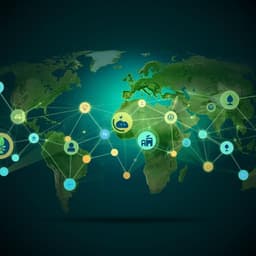
Interdisciplinary Studies
Global transboundary synergies and trade-offs among Sustainable Development Goals from an integrated sustainability perspective
H. Xiao, S. Bao, et al.
This groundbreaking study explores the intricate transboundary interactions of Sustainable Development Goals (SDGs), unveiling insights from data across 768 pairs of SDG indicators. The researchers, including Huijuan Xiao and Sheng Bao, highlight the significant role of high-income countries and the importance of collaboration for achieving global SDG targets.
~3 min • Beginner • English
Introduction
The study addresses how domestic progress on the 17 Sustainable Development Goals (SDGs) can produce transboundary spillovers—both synergies and trade-offs—through human-caused and nature-caused flows in an interconnected world. Traditional sustainability perspectives emphasize weak (interchangeable pillars of economy, society, environment) and strong (prioritizing environment) sustainability. This paper advances the integrated sustainability perspective, which adds spillover effects as a fourth pillar alongside economy, society, and environment. Given pervasive cross-border linkages via international trade, transboundary rivers, ocean currents, and air flows, the research aims to determine whether each SDG indicator exerts positive or negative effects on others abroad, quantify those effects, and construct a unified index to measure the magnitude and components of such interactions across countries. Understanding these interactions is crucial for coordinated global progress toward the 2030 Agenda.
Literature Review
Prior work documents widespread cross-border SDG interactions, including technological spillovers from multinationals, benefits from international trade, and negative externalities such as pollution crossing borders via air and water. The literature debates globalization’s role: comparative advantage suggests welfare and sustainability gains from openness, whereas pollution haven hypotheses highlight potential environmental degradation shifts. Studies have also challenged Tobler’s first law of geography by showing distant consumption driving habitat loss and fisheries impacts through trade. Despite these insights, quantifying transboundary SDG interactions remains challenging due to multiple concurrent transmission channels and heterogeneous outcomes across socio-environmental domains. This study builds on metacoupling/telecoupling frameworks to systematically capture and quantify spillovers among SDGs across nations.
Methodology
Design: The study evaluates transboundary interactions among 121 countries (2010–2020) across 55 SDG indicators, forming 768 indicator pairs with documented causal relationships derived from a curated repository (systematic review of 65 global assessments, UN reports, and 112 scientific articles). Values of indicators were normalized to 0–100.
Channels and spatial weights: Two categories of flows were modeled via spatial weight matrices (W) with zero diagonals and row-standardization.
- Human-caused flows: International trade matrices W_trade,t constructed from Eora26 MRIO (2010–2020), with cell values as bilateral value-added flows (USD).
- Nature-caused flows:
1) River flow (W_river): Built using HydroSHEDS (15 arc-second resolution), identifying 2,126 transboundary rivers and aggregating long-term discharge (m3/s) linking countries. Applied to 102 SDG6-related indicator pairs.
2) Ocean currents (W_maritime): Binary adjacency among 91 coastal countries (of 121 total) based on maritime boundaries (UNCLOS) for 45 SDG14-related pairs.
3) Air flow (W_air): Inverse-distance matrix using country centroids for 36 pairs involving target 11.6 (fine particulate matter).
Estimation: Spatial dynamic panel econometric models with a two-stage instrumental variable (2SIV) approach addressed endogeneity from socioeconomic-based weights. First-stage regression modeled ln trade flows using instruments capturing economy, population, governance, internet access, export performance, and technology. Second-stage models estimated:
- Single-channel: ln SDG_imt = c_i + ρ ln SDG_im,t−1 + λ1 Σj w_ij SDG_jnt + X_2it β + δ_t + v_it
- Multi-channel (for SDG6, SDG14, 11.6): inclusion of both λ1 (trade) and λ2 (nature-flow) using corresponding W matrices.
Significance threshold: Spatial coefficients significant at ≥10% were retained.
Spatial interaction index: For each SDG indicator (as receiver), absolute values of significant spatial coefficients across relevant channels were summed and min–max normalized to 0–100 to derive interaction magnitude. The overall spatial interaction index for a country equals the arithmetic mean across indicators. Decomposition into four components—synergies/trade-offs via trade and via nature flows—used percentage shares based on the sum of absolute significant coefficients by sign and channel. Additional analyses:
- Income groups: Countries grouped by World Bank income levels (2022–2023); trade-related interactions compared by constructing group-specific sparse W and re-estimating.
- Neighbour vs non-neighbour: Neighbouring status defined via shared vertex/land boundary (queen contiguity) or maritime boundary; separate matrices built to compare interaction magnitudes.
Data sources: Eora26 MRIO, HydroSHEDS, CIA World Factbook (coastal/inland), UN SDG Global Database, World Bank, Our World in Data. Code for spatial econometric models referenced (doi:10.1111/ectj.12069) and available upon request from the corresponding author.
Key Findings
- Dominance of synergies: Among linkages via international trade, 73.68% were synergistic and 26.32% trade-offs. For nature-caused flows, 81.82% were synergistic and 18.18% trade-offs, indicating trade linkages are more prone to counterproductive effects than nature flows.
- Indicator linkage hubs:
• Trade channel: Target 7.1 (access to affordable, reliable, modern energy services) had the most cross-border linkages (29) spanning basic services (1.4), agriculture (2.3), water use efficiency (6.4), housing (11.1), and biodiversity (15.5). Table evidence shows a positive, significant spatial lag of 7.1 via trade promoting 6.4 in partner countries (e.g., λ ≈ 0.038, p<0.01).
• Nature flows: Target 6.6 (protect and restore water-related ecosystems) affected 19 indicators abroad. The spatial lag via river flow was 0.094 (p<0.01) promoting basic sanitation (1.4) in connected downstream countries.
- Spatial interaction index (0–100 scale): Across countries, synergistic effects composed 78.97% of total interactions—3.76 times trade-offs—indicating cross-border interactions generally facilitate SDG progress.
• By channel: Synergies constituted 90.71% of nature-flow interactions and 73.76% of trade interactions.
• By SDG: Strongest transboundary synergies were for SDG 12 (score 39.38), SDG 2 (32.13), and SDG 6 (36.49).
• By indicator: Target 6.6 received the strongest synergies (88.74), split between trade (55.45) and nature flows (33.29). Net effect (synergies minus trade-offs) for 6.6 was 77.49 due to low trade-offs (11.25).
- Income group contributions: High-income countries accounted for 60.60% of the global magnitude of transboundary SDG interactions (2010–2020), despite only 14.18% of global population. They contributed 64.95% of global synergies and 44.06% of global trade-offs, and had the highest synergy share within their own interactions (84.85%).
- Neighbour vs non-neighbour:
• Trade: Synergies were 14.94% stronger with non-neighbouring partners than neighbours; trade-offs were 17.81% stronger between neighbouring trade partners. Net effects via trade were 35.46% stronger for non-neighbour pairs.
• Nature flows: Neighbouring countries had 39.29% stronger synergies than non-neighbours; non-neighbours had 1.88% stronger trade-offs. Net effects via nature flows were 45.59% stronger among neighbours.
- Trade relationships by income and proximity: Synergy shares among total interactions for neighbours vs non-neighbours, respectively: High income 72.83% vs 86.07% (18.14% stronger synergies with non-neighbours); Upper-middle 72.46% vs 73.61%; Lower-middle 72.96% vs 56.76%; Low income 69.07% vs 62.73%.
Discussion
The analysis quantifies the fourth pillar of integrated sustainability—cross-border spillover effects—alongside social, environmental, and economic pillars. Results indicate that globalization and openness predominantly foster synergistic transboundary effects via trade, aligning with comparative advantage while acknowledging the presence of trade-offs highlighted by pollution haven concerns. Systemic interlinkages can create virtuous or vicious cycles: progress (or regress) on one indicator in one country can amplify outcomes across multiple indicators abroad. Geographic proximity shapes outcomes differently by channel: contrary to Tobler’s law for trade, non-neighbour trade partners exhibit stronger synergies, reflecting diversified global value chains and international institutions; yet nature flows conform more closely to proximity effects, with stronger synergies among neighbours via rivers, ocean currents, and air pathways. Policy implications include shifting from place-based to flow-based governance that identifies, monitors, and manages critical transboundary flows; internalizing externalities by compensating for cross-border trade-offs and subsidizing synergies; and deploying internationally tradable pollution permits to manage cross-border emissions. Expanding the scope to additional human- and nature-driven flows and improving spatiotemporal characterization of connectivity can further enhance governance for the 2030 Agenda.
Conclusion
This study develops and applies a comprehensive framework to quantify transboundary SDG synergies and trade-offs across 121 countries, 55 indicators, and 768 causally linked indicator pairs through international trade and nature-caused flows (rivers, ocean currents, air). A unified spatial interaction index (0–100) and its decomposition reveal that synergies dominate globally—especially via nature-caused flows—while trade-driven interactions are also predominantly synergistic. High-income countries, despite a smaller population share, account for most global transboundary interactions and a large share of synergies, underscoring their disproportionate influence and responsibility. Proximity matters by channel: non-neighbour trade ties yield stronger synergies, whereas neighbouring countries benefit more via nature flows. Policymakers should leverage flow-based governance, strengthen international cooperation, and internalize cross-border externalities to amplify synergies and reduce trade-offs. Future research should incorporate additional flows (e.g., maritime shipping, technology transfer, investment, migration, knowledge diffusion, disease spread), refine flow directionality and dynamics with remote sensing and physical models, and test alternative proximity thresholds to improve causal attribution and policy design.
Limitations
- Indicator coverage: Only 55 indicators (out of 231) were analyzed, potentially omitting relevant SDG linkages.
- Channel scope: Human-caused flows were represented primarily by international trade; other important flows (e.g., maritime transport volumes, FDI, technology transfer, migration) were not modeled due to data constraints.
- Nature-flow modeling: Sparse adjacency (ocean currents, river basins) and simplified inverse-distance air flow may under-represent complex, dynamic, and directional transport processes; more sophisticated hydrodynamic/atmospheric modeling could improve accuracy.
- Proximity definitions: Neighbour vs non-neighbour classifications are context-dependent; alternative distance thresholds could yield different comparative results.
- Econometric assumptions: Despite 2SIV to address endogeneity in spatial weights, residual endogeneity or measurement error may persist; results depend on instrument quality and data availability.
- Data availability and temporal resolution: Cross-country data heterogeneity, reporting lags, and 2010–2020 coverage may limit generalizability to other periods or countries outside the 121-sample set.
Related Publications
Explore these studies to deepen your understanding of the subject.







